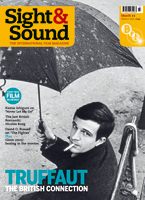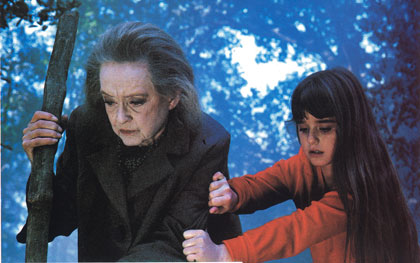Primary navigation


What’s the missing link between Tron, The Legend of Hell House and a big blue alien? For Joseph Stannard, it’s Disney’s cult 1980 fantasy The Watcher in the Woods
A girl sits alone in the woods, playing with her doll. An unseen presence approaches from behind. The girl turns. Her features gather into an expression of terror. She drops her doll and flees. As she runs, her doll is struck by a beam of blue light and bursts into flames. Roll credits.
That’s how Disney’s cult fantasy The Watcher in the Woods doesn’t begin – at least, not since October 1980, when the film received a limited preview run in New York that culminated in its abrupt withdrawal from release. Instead, we are swiftly introduced to the Curtis family – Helen (Carroll Baker), Paul (David McCallum) and their daughters Jan (Lynn-Holly Johnson) and Ellie (Kyle Richards) – who take up residence in a country pile owned by the irascible Mrs Aylwood (Bette Davis). As it turns out, Aylwood’s daughter Karen disappeared 30 years ago, and the matriarch’s stern visage is softened by Jan’s resemblance to her missing child. Through a series of uncanny events involving circles of blue light, near-fatal accidents and disturbing visions of the absent daughter, Jan comes to understand the truth behind her doppelgänger’s disappearance – even if the audience isn’t sure what on earth is going on.
Based on a 1976 novel by Florence Engel Randall, and directed by English journeyman John Hough, The Watcher in the Woods is a beautifully shot, well-acted (21-year-old Johnson is especially terrific) curio, an oddball artefact from the period in Disney’s history when the studio was making a bid for relevance in the post-Star Wars landscape of mainstream cinema. This period also produced cult favourites such as The Black Hole and Tron, but neither of those can boast the decidedly troubled history – nor the eerie atmosphere – of this production. Unhappy with its initial reception, Disney recalled the film and embarked on a tortuous process of rewrites (there were reportedly 152 possible conclusions in the running) and reshoots that resulted in two variant endings, one of which made the final cut while the other, which was to utilise special effects to create an alien world, remained unfinished. Meanwhile, tales abound of tension on the set involving an irritable Bette Davis, nervous executives and an embattled director.
Some critics have argued that The Watcher in the Woods mimics the tropes of the slasher film (albeit without featuring any actual slashing), particularly the point-of-view camera that stalks its female ‘prey’ through the woods. The title alone is enough to suggest something that could be found on the racks between The Burning and The House by the Cemetery, while the ‘lost’ opening sequence wouldn’t have seemed out of place in the Friday the 13th franchise.
Producer Tom Leetch initially pitched the project as “our Exorcist” and the sense of a production straining against its limitations is palpable. In its widely distributed form, the film seems to be building towards an epic revelation that never materialises, and while the climactic ritual is staged with the intensity of a Hammer classic, the resolution takes place, in stereotypically Disney style, amid hugs and smiles. Nothing is lost and everyone gets their wish.
John Hough had already directed Escape to Witch Mountain (1974) and its sequel Return from Witch Mountain (1978) for Disney, demonstrating adeptness at exposing a young audience to paranormal chills. With this in mind, it’s curious to observe how Watcher edges towards genuine terror before retreating back into Disney’s comfort zone. Some blame studio executive Ron Miller for this inconsistency of tone, his reluctance to allow the film its darker elements resulting in a series of unhappy compromises. Journalist Scott Michael Bosco, an advocate of the film who worked on its 2002 Anchor Bay DVD release, claims it was Leetch who opposed Miller’s interference, while a cowed Hough backed away from confrontation. Even so, one can detect the directorial touch of the man who made the underrated 1973 horror The Legend of Hell House.
Then there’s the issue of the big blue alien. Though cult film lore has it that the “Watcher” revealed towards the end of the original 1980 film was an unconvincing shambles, the reality couldn’t be further from the truth. Watching the alternate ending – included on the now-deleted Anchor Bay DVD and available to view on YouTube – there’s a considerable frisson generated by this blue-skinned, part-insect, part-reptile apparition with glowing amber eyes and swivelling mandibles. The creature’s wing movement is admittedly a little Muppet-like, yet I can recall being utterly petrified by far less convincing monster effects in contemporaneous episodes of Doctor Who. For me, the Watcher represents an accomplished stab at creating something genuinely strange and non-human for the edification of a young audience. As a friend recently ventured, you could call it “Giger meets Ghostbusters”.
But all this is academic. In the absence of a director’s cut, the only complete version of the film we have is the 1981 theatrical release, without the big blue beast. It’s all too tempting to consider what could have been, or indeed what briefly was, given that the original 1980 cut remains similarly out of reach. Nevertheless, even in its most widely viewed form The Watcher in the Woods is a haunting, unusual film, steeped in a strange magic that’s only enhanced by the dense thicket of rumour and myth that surrounds it.
“It is not surprising, given the contradictory notion of a Disney horror movie, to find that, for all its atmospheric shots of misty woods and gnarled tree stumps at the beginning, The Watcher in the Woods is really an anti-horror exercise. Everyone is nice, or rather turns out to be. That this is as much a fantasy world as Snow White, only more dishonest because of its attempts at naturalism, is confirmed by the total isolation of the setting and the extreme sketchiness of the adult characters.”
— Bill Marshall, Monthly Film Bulletin, September 1982
Raising hell: Mark Kermode on Ken Russell’s exorcised The Devils (December 2002)
Bride of Chucky reviewed by Linda Ruth Williams (July 1999)